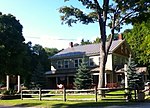Green Mountain National Forest is a national forest located in Vermont, a temperate broadleaf and mixed forest typical of the New England/Acadian forests ecoregion. The forest supports a variety of wildlife, including beaver, moose, coyote, black bear, white-tailed deer, wild turkey, and ruffed grouse. The forest, being situated in Vermont's Green Mountains, has been referred to as the granite backbone of the state.
Established in 1932 due to uncontrolled overlogging, fire and flooding, the forest originally consisted of 102,100 acres (413 km2); however, only 1,842 acres (7.45 km2) were federally owned, while the remaining 100,258 acres (405.73 km2) within the national forest boundary were not federally owned or administered. As of 2011, the forest boundaries included 821,040 acres (3,322.6 km2), of which 399,151 acres (1,615.31 km2) were federally owned and administered. GMNF is one of only two national forest areas in New England, the other area being the White Mountain National Forest in New Hampshire.
In descending order of land area, GMNF is located in parts of Bennington, Addison, Rutland, Windham, Windsor, and Washington counties. The forest headquarters are in Mendon, Vermont, alongside those of Finger Lakes National Forest though that forest is in New York state.The forest contains three nationally designated trails, including parts of the Appalachian Trail and the Long Trail, as well as the Robert Frost National Recreation Trail. The forest also includes three alpine ski areas, seven Nordic ski areas, and approximately 900 mi (1,400 km) of multiple-use trails for hiking, cross country skiing, snowmobiling, horseback riding, and bicycling.The forest benefited from the American Reinvestment and Recovery Act of 2009. Forest revenue is generated by recreation fees (such as at Mount Snow, Stratton Mountain and Bromley Mountain ski areas) and timber sales. About 42 acres (17 ha) were set aside for forest regeneration in 2009. Planned expenditures include road construction, recreation and heritage, and wildlife management. Projects in the latter category include: land/water modification in support of ruffed grouse, wild turkeys, bear, trout, salmon, Bicknell's thrush, and the plant Jacob's ladder. The emerald ash borer is a threat to Vermont's trees.








